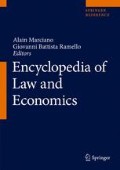Abstract
This entry reviews the literature on the economics of organized crime. While the economics of organized crime is a small subfield of economics, it can offer insights in unexpected areas of economics. The field began some 40 years ago with the study of organized crime and its participation in illicit activities such as prostitution and gambling. Over time, the economic analysis of organized crime has expanded to address broader questions of governance in the absence of formal institutions.
Access this chapter
Tax calculation will be finalised at checkout
Purchases are for personal use only
References
Anderson AG (1979) The business of organized crime: a Cosa Nostra family. The Hoover Institution, Stanford
Anderson AG (1995) Organized crime, mafia, and governments. In: Fiorentini G, Peltzman S (eds) The economics of organized crime. Cambridge University Press, Cambridge, UK, pp 33–54
Backhaus J (1979) Defending organized crime? A note. J Leg Stud 8:623–631
Baker MJ, Bulte EH (2010) Kings and Vikings: on the dynamics of competitive agglomeration. Econ Gov 11:207–227
Becker GS (1968) Crime and punishment: an economic approach. J Polit Econ 76:169–217
Bouchard M, Wilkins C (eds) (2010) Illegal markets and the economics of organized crime. Routledge, London/New York
Buchanan J (1973) A defense of organized crime. In: Rottenberg S (ed) Economics of crime and punishment. American Enterprise Institute, Washington, DC, pp 119–132
Clay KB (1995) Trade without law: private-order institutions in Mexican California. J Law Econ Org 13:202–231
Cressey DR (1969) Theft of the nation: the structure and operations of organized crime in America. Harper and Row, New York
Dick AR (1995) When does organized crime pay? A transactions cost analysis. Int Rev Law Econ 15:25–45
Finckenauer JO (2005) Problems of definition: what is organized crime? Trends Organ Crime 8:63–83
Fiorentini G (1995) Oligopolistic competition in illegal markets. In: Fiorentini G, Peltzman S (eds) The economics of organized crime. Cambridge University Press, Cambridge, UK, pp 274–288
Fiorentini G (2000) The economics of organized crime. In: Bouckaert B, De Geest G (eds) Encyclopedia of law and economics, volume V: the economics of crime and litigation. Edward Elgar, Cheltenham, pp 434–459
Fiorentini G, Peltzman S (eds) (1995a) The economics of organized crime. Cambridge University Press, Cambridge, UK
Fiorentini G, Peltzman S (1995b) Introduction. In: Fiorentini G, Peltzman S (eds) The economics of organized crime. Cambridge University Press, Cambridge, UK, pp 1–30
Garoupa N (2000) The economics of organized crime and optimal law enforcement. Econ Inq 38:278–288
Garoupa N (2007) Optimal law enforcement and criminal organization. J Econ Behav Organ 63:461–474
Greif A (1993) Contract enforceability and economic institutions in early trade: the Maghribi traders’ coalition. Am Econ Rev 83:524–548
Grossman HI (1995) Rival kleptocrats: the mafia versus the state. In: Fiorentini G, Peltzman S (eds) The economics of organized crime. Cambridge University Press, Cambridge UK, pp 143–155
Grossman HI, Kim M (1995) Swords or plowshares? A theory of the security of claims to property. J Polit Econ 103:1275–1288
Hirshleifer J (1988) The analytics of continuing conflict. Synthèse 76:201–233
Kaplan LJ, Kessler D (1976) An economic analysis of crime: selected readings. Charles C. Thomas, Springfield
Kaplan LJ, Matteis S (1976) The economics of loansharking. In: Kaplan LJ, Kessler D (eds) An economic analysis of crime: selected readings. Charles C. Thomas, Springfield, pp 178–192
Kugler M, Verdier T, Zenou Y (2005) Organized crime, corruption, and punishment. J Public Econ 89:1639–1663
Levitt SD, Venkatesh SA (2000) An economic analysis of a drug-selling gang’s finances. Q J Econ 115:755.89
Mansour A, Marceau N, Mongrain S (2006) Gangs and crime deterrence. J Law Econ Organ 22:315–339
Milhaupt CJ, West MD (2000) The dark side of private ordering: an institutional and empirical analysis of organized crime. Univ Chic Law Rev 67:41–98
Polo M (1995) Internal cohesion and competition among criminal organizations. In: Fiorentini G, Peltzman S (eds) The economics of organized crime. Cambridge University Press, Cambridge, UK, pp 87–103
Reuter P (1983) Disorganized crime: the economics of the visible hand. MIT Press, Cambridge, MA
Schelling TC (1967) Economics and the criminal enterprise. Public Interest 7:61–78
Schelling TC (1971) What is the business of organized crime? Am Sch 40:643–652
Skaperdas S (1992) Cooperation, conflict, and power in the absence of property rights. Am Econ Rev 82:720–739
Skaperdas S (2001) The political economy of organized crime: providing protection when the state does not. Econ Gov 2:173–202
Skaperdas S, Konrad K (2012) The market for protection and the origin of the state. Econ Theory 50:417–443
Skaperdas S, Syropoulos C (1995) Gangs and primitive states. In: Fiorentini G, Peltzman S (eds) The economics of organized crime. Cambridge University Press, Cambridge, UK, pp 61–81
Task Force Report: Organized Crime (1967) The President’s commission on law enforcement and administration of justice. U. S. Government Printing Office, Washington, DC
Turvani M (1997) Illegal markets and the new institutional economics. In: Menard C (ed) Transactions cost economics. Edward Elgar, Cheltenham
Author information
Authors and Affiliations
Corresponding author
Editor information
Editors and Affiliations
Rights and permissions
Copyright information
© 2019 Springer Science+Business Media, LLC, part of Springer Nature
About this entry
Cite this entry
Baker, M.J. (2019). Crime: Organized Crime and the Law. In: Marciano, A., Ramello, G.B. (eds) Encyclopedia of Law and Economics. Springer, New York, NY. https://doi.org/10.1007/978-1-4614-7753-2_16
Download citation
DOI: https://doi.org/10.1007/978-1-4614-7753-2_16
Published:
Publisher Name: Springer, New York, NY
Print ISBN: 978-1-4614-7752-5
Online ISBN: 978-1-4614-7753-2
eBook Packages: Economics and FinanceReference Module Humanities and Social SciencesReference Module Business, Economics and Social Sciences

